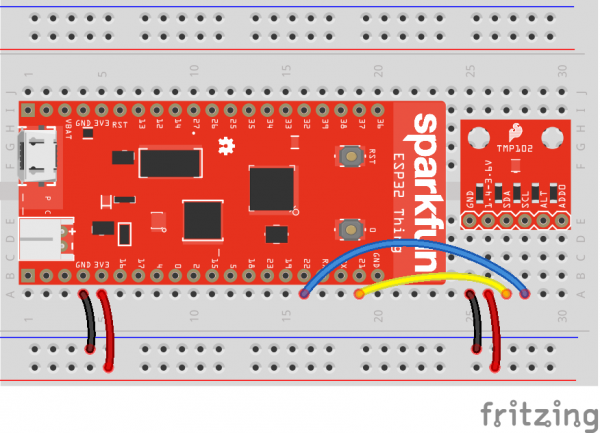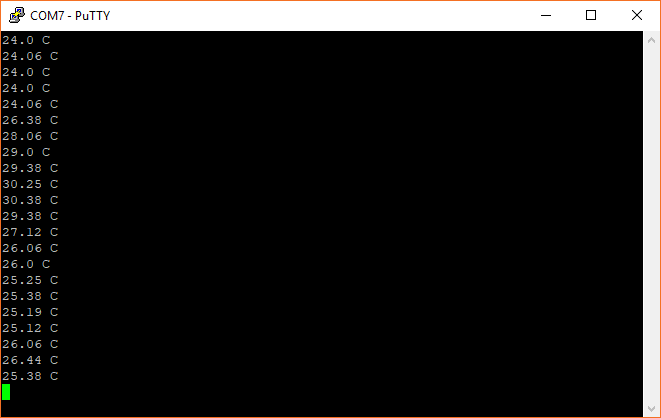MicroPython Programming Tutorial: Getting Started with the ESP32 Thing
Experiment 4: I2C
Inter-Integrated Circuit (I2C) is a communication protocol designed to allow one "master" chip to communicate with several "device" chips on the same bus. Many modern sensors rely on I2C for communication, as it is a relatively easy protocol to implement and requires only 2 signal lines. If you would like to learn more about how I2C works, see this tutorial.
In this experiment, we are going to connect a TMP102 temperature sensor to the ESP32 Thing and read the ambient temperature.
Hardware Connections
Connect the TMP102 to the ESP32 as follows:
Code: It's Getting Hot in Here
In a new file, enter the following code:
language:python
import machine
import sys
import utime
###############################################################################
# Parameters and global variables
# Pin definitions
repl_button = machine.Pin(0, machine.Pin.IN, machine.Pin.PULL_UP)
repl_led = machine.Pin(5, machine.Pin.OUT)
sda_pin = machine.Pin(21)
scl_pin = machine.Pin(22)
# Create an I2C object out of our SDA and SCL pin objects
i2c = machine.I2C(sda=sda_pin, scl=scl_pin)
# TMP102 address on the I2C bus
tmp102_addr = 0x48
# TMP102 register addresses
reg_temp = 0x00
reg_config = 0x01
###############################################################################
# Functions
# Calculate the 2's complement of a number
def twos_comp(val, bits):
if (val & (1 << (bits - 1))) != 0:
val = val - (1 << bits)
return val
# Read temperature registers and calculate Celsius
def read_temp():
# Read temperature registers
val = i2c.readfrom_mem(tmp102_addr, reg_temp, 2)
temp_c = (val[0] << 4) | (val[1] >> 5)
# Convert to 2s complement (temperatures can be negative)
temp_c = twos_comp(temp_c, 12)
# Convert registers value to temperature (C)
temp_c = temp_c * 0.0625
return temp_c
# Initialize communications with the TMP102
def init():
# Read CONFIG register (2 bytes) and convert to integer list
val = i2c.readfrom_mem(tmp102_addr, reg_config, 2)
val = list(val)
# Set to 4 Hz sampling (CR1, CR0 = 0b10)
val[1] = val[1] & 0b00111111
val[1] = val[1] | (0b10 << 6)
# Write 4 Hz sampling back to CONFIG
i2c.writeto_mem(tmp102_addr, reg_config, bytearray(val))
###############################################################################
# Main script
# Print out temperature every second
while True:
# If button 0 is pressed, drop to REPL
if repl_button.value() == 0:
print("Dropping to REPL")
repl_led.value(1)
sys.exit()
# Read temperature and print it to the console
temperature = read_temp()
print(round(temperature, 2), "C")
utime.sleep(1)
Save the file with a name such as i2c.py. In a command terminal, navigate to the directory with your i2c.py file. Hold down button 0 until you see the blue LED turn on to let you know that you have entered the REPL. In the command terminal, enter the following commands (change <PORT> to your port name/location):
language:shell
cp i2c.py main.py
ampy --port <PORT> put main.py
Open a serial connection to the ESP32, and you should see temperature value (in Celsius) being reported once per second.
Try breathing warm air onto the TMP102 sensor to see if you can change the temperature values.
Code to Note
This code is much longer than our previous examples. This is due to us needing to send configuration information to the TMP102, read temperature, and then perform some calculations on the raw data to get a human-readable temperature value.
Every time we want to communicate with the TMP102, we send out its address (0x48) on the bus. From there, we usually send the memory location (address) of the register that we intend to read from or write to on the TMP102. For most I2C devices, a register is a location in the device's memory that stores 1 byte (8 bits) of data. Some registers control the function of the device (for example, the CONFIG register in the TMP102). Other registers hold sensor data readings (such as the TEMP register in the TMP102) that we must read from.
To communicate on an I2C bus, we create a machine.I2C object, passing it the pins we intend to use for SDA and SCL:
language:python
i2c = machine.I2C(sda=sda_pin, scl=scl_pin)
We use the following command to read 2 bytes from the temperature register in the TMP102:
language:python
val = i2c.readfrom_mem(tmp102_addr, reg_temp, 2)
These values are stored as a list [x, y] in the val variable. By looking at the TMP102 datasheet, we see that temperature is 12 bits. When we read the two bytes that contain this reading, we need to remove the last 4 bits from the second byte. We also move the first byte over 4 bits:
language:python
temp_c = (val[0] << 4) | (val[1] >> 5)
In order to display negative numbers for the temperature, values from the TMP102 come in the form of Two’s Complement. In this, the first bit of the 12-bit number determines if the value is positive or negative (0 for positive, 1 for negative). See this article to learn more about Two’s Complement.
To convert a Two’s Complement number to a negative number in Python, we check to see if the first bit is 0 or 1. If it is 0, then we just use the number as is (it’s positive!). If it’s a 1, we subtract the max negative number of the Two’s Complement (212=4096 in this case) from our number.
language:python
if (val & (1 << (bits - 1))) != 0:
val = val - (1 << bits)
Finally, we multiply this two's complement number by 0.0625 to convert the raw value into a Celsius value. Refer out Table 5 in the TMP102 datasheet to see how the raw-to-Celsius calculation is performed.


